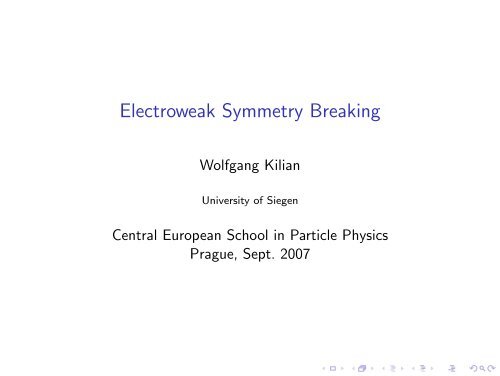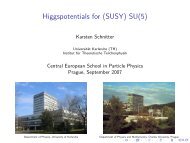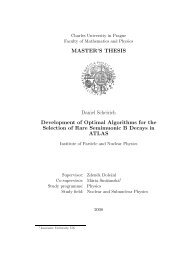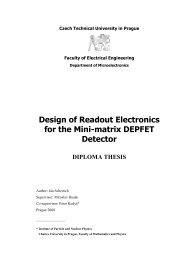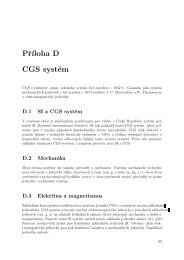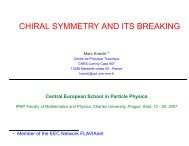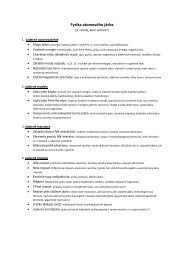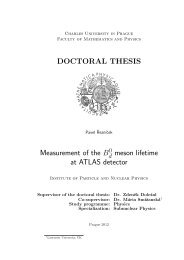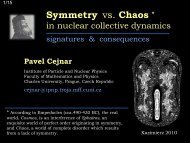Electroweak Symmetry Breaking
Electroweak Symmetry Breaking
Electroweak Symmetry Breaking
- No tags were found...
Create successful ePaper yourself
Turn your PDF publications into a flip-book with our unique Google optimized e-Paper software.
<strong>Electroweak</strong> <strong>Symmetry</strong> <strong>Breaking</strong><br />
Wolfgang Kilian<br />
University of Siegen<br />
Central European School in Particle Physics<br />
Prague, Sept. 2007
PART I<br />
The pedestrian way to the TeV scale
Effective Theory<br />
Building Blocks: Quarks and Leptons<br />
Q L =<br />
L L =<br />
(<br />
UL<br />
)<br />
, Q<br />
D R =<br />
L<br />
)<br />
, L<br />
E R =<br />
L<br />
(<br />
NL<br />
(<br />
UR<br />
)<br />
,<br />
D R<br />
)<br />
.<br />
E R<br />
(<br />
NR<br />
and the photon<br />
A µ
Effective theory:<br />
Generic Lagrangian consistent with the known or assumed<br />
symmetries.<br />
L = L(Q L , Q R , L L , L R , A)<br />
Here: Electromagnetic gauge invariance
Organizing principle:<br />
Dimensionality of the terms in the Lagrangian<br />
◮ Dimension < 4: “relevant operators”<br />
◮ Dimension = 4: “marginal operators”<br />
◮ Dimension > 4: “irrelevant operators”
Start with the lowest dimension:<br />
Dimension 2: Photon mass – forbidden by electromagnetic gauge<br />
symmetry<br />
Dimension 3: Fermion Masses:<br />
L 3 = −( ¯Q L M Q Q R + ¯L L M L L R + h.c.)<br />
− ( ¯N c L M N L<br />
N L + ¯N c R M N R<br />
N R ),<br />
This contains both Dirac and Majorana mass terms
Gauge invariance relates kinetic energy and electromagnetic<br />
interactions:<br />
D µ = ∂ µ + ieqA µ ,<br />
A µν = ∂ µ A ν − ∂ ν A µ ,<br />
so the massless QED Lagrangian is<br />
L 4 = ¯Q L i /DQ L + ¯Q R i /DQ R + ¯L L i /DL L + ¯L R i /DL R − 1 4 A µνA µν .<br />
Dimension-4 Lagrangian: coefficients have zero mass dimension.<br />
Numeric couplings:<br />
q Q = y Q + τ 3<br />
2<br />
with constants y Q = 1 3 and y L = −1.<br />
, q L = y L + τ 3<br />
,<br />
2
Weak interactions: Fermi model<br />
L 6 = −4 √ 2 G F<br />
(<br />
2J<br />
+<br />
µ J µ− + ρ ∗ J 0 µJ µ0) ,<br />
with charged and neutral currents<br />
J µ ± = √ 1 [<br />
¯QL τ ± γ µ V (†)<br />
2<br />
CKM Q L + ¯L<br />
]<br />
L τ ± γ µ L L ,<br />
[<br />
Jµ 0 = ¯Q L<br />
(−q Q sw 2 + τ 3<br />
2<br />
(<br />
+¯L L −q L sw 2 + τ 3<br />
2<br />
)<br />
γ µ Q L + ¯Q R (−q Q s 2 w )γ µ Q R<br />
)<br />
γ µ L L + ¯L R (−q L s 2 w )γ µ L R<br />
]<br />
.<br />
Dimension-6 Lagrangian: coefficients have negative mass<br />
dimension.
Proposition:<br />
This model has a hidden SU(2) × U(1) invariance.<br />
. . . that is (almost) a gauge invariance, i.e., local symmetry
The current-current interaction allows for rewriting it as couplings<br />
of currents to auxiliary vector fields W + µ , W − µ , Z µ :<br />
where<br />
L 6 = −g W (W +µ J + µ + W −µ J − µ ) − g Z (Z µ J 0 µ) + L 2(W ) ,<br />
L 2(W ) = M 2 W W +µ W − µ + 1 2 M2 Z Z µ Z µ .<br />
The vector fields are auxiliary; they can be eliminated by their<br />
equations of motion:<br />
W ± µ<br />
= g W<br />
MW<br />
2 Jµ ∓ ,<br />
Z µ = g Z<br />
MZ<br />
2 Jµ,<br />
0
We have obtained vector-current couplings<br />
gW 2 = 4M2 W<br />
v 2 and gZ 2 = ρ 4MZ<br />
2 ∗<br />
v 2 .<br />
and the characteristic scale of electroweak symmetry:<br />
v ≡ ( √ 2 G F ) −1/2 = 246 GeV
To identify SU(2) L × U(1), we introduce a SU(2) L triplet of vector<br />
fields W a µ and a U(1) vector field B µ :<br />
and<br />
W + = 1 √<br />
2<br />
(W 1 − iW 2 )<br />
W − = 1 √<br />
2<br />
(W 1 + iW 2 )<br />
Z = c w (1 + x Z )W 3 − s w (1 + y Z )B,<br />
A = s w (1 + x A )W 3 + c w (1 + y A )B,<br />
(Apart from A µ , all vector fields are still auxiliary)
The Lagrangian of a gauge-invariant theory should have the form<br />
L = ¯Q L i /D L Q L + ¯Q R i /D R Q R + ¯L L i /D L L L + ¯L R i /D R L R<br />
+ kinetic terms for gauge bosons<br />
Covariant derivatives for SU(2) L × U(1) have the generic form<br />
(<br />
D Lµ = ∂ µ + i g 1q ′ − g 2<br />
′<br />
(<br />
D Rµ = ∂ µ + i g 3q ′ − g 4<br />
′<br />
τ 3 )<br />
B µ + igW a τ a<br />
µ<br />
2<br />
2 ,<br />
τ 3<br />
2<br />
)<br />
B µ ,<br />
The current-vector couplings of the weak interactions do have this<br />
form, if we identify
Charged coupling:<br />
g W = g.<br />
No right-handed W couplings, and correct neutral-W<br />
normalization:<br />
U(1) anomaly free:<br />
g Z = 1<br />
c w<br />
(1 − x Z )g<br />
g = e<br />
s w<br />
(1 + x A )<br />
g i ′ = g ′ , i = 1, 2, 3, 4,<br />
y A + x Z = x A + y Z<br />
g ′ = e (1 + y A )<br />
c w
The symmetry is in the covariant derivatives, but not in the mass<br />
terms.<br />
To correct this, introduce a 2 × 2 matrix-valued field Σ with<br />
Σ † Σ = ΣΣ † = 1<br />
Such a field has three free parameters w 1 , w 2 , w 3 :<br />
Σ(x) = exp<br />
(− i )<br />
v w(x) with w(x) = w a (x) τ a , a = 1, 2, 3,<br />
We define the gauge transformation of Σ and thus the covariant<br />
derivative of Σ:<br />
D µ Σ = ∂ µ Σ + igW µ Σ − ig ′ ΣB µ ,
With this definition, we rewrite<br />
and<br />
L 3 = −( ¯Q L ΣM Q Q R + ¯L L ΣM L L R + h.c.)<br />
− ¯L c 1 + τ 3<br />
L Σ∗ M NL ΣL L −<br />
2<br />
¯L c R M 1 + τ 3<br />
N R<br />
L R ,<br />
2<br />
L 2(W ) = v 2<br />
4 tr [<br />
(D µ Σ)(D µ Σ) †] − β ′ v 2<br />
where some abbreviations are useful:<br />
V µ = Σ(D µ Σ) † and T = Στ 3 Σ † ,<br />
8 tr [TV µ] tr [TV µ ]
Intermediate Result:<br />
With the help of auxiliary fields, we have made explicit a hidden<br />
symmetry of the weak interactions . . .<br />
. . . except for the gauge-boson kinetic energy:<br />
L em = − 1 4 A µνA µν<br />
Therefore, if we argue that SU(2) × U(1) symmetry has physical<br />
content, we predict the existence of physical gauge bosons, and<br />
their associated kinetic terms:
Field-strength tensors:<br />
W µν = ∂ µ W ν − ∂ ν W µ + ig[W µ , W ν ],<br />
B µν = ∂ µ B ν − ∂ ν B µ ,<br />
where<br />
⇒ kinetic term<br />
W µ = Wµ<br />
a τ a<br />
2<br />
and B µ = B µ<br />
τ 3<br />
2 .<br />
L 4(W ) = − 1 2 tr [W µνW µν ] − 1 2 tr [B µνB µν ] .
Experimental Consequences I<br />
◮ Existence of two charged (W + , W − ) and one neutral (Z)<br />
vector boson<br />
◮ This was confirmed in the 80’s, and the properties of those<br />
were measured in detail in the 90’s.<br />
◮ <strong>Symmetry</strong> predicts the existence of those, but neither masses<br />
nor couplings. (Note the appearance of x A , y A , x Z .) These are<br />
free parameters.
Theoretical interpretation<br />
We have just rewritten the electromagnetic + weak interactions as<br />
a model with local SU(2) L × U(1) Y gauge invariance.<br />
Due to gauge invariance, we can choose w a = 0 and thus Σ = 1 as<br />
a gauge, so the fields w a are unphysical. Thus, the model has no<br />
physical degrees of freedom in addition to the fermions and<br />
massive vector bosons.<br />
Turning this around, any model of fermions and massive vector<br />
bosons can be written as a spontaneously broken gauge theory.
We can, however, keep w a ≠ 0 and derive Feynman rules for those.<br />
(Including some gauge-fixing term), they become interacting scalar<br />
fields. This implies expanding the Lagrangian around some ground<br />
state, e.g., Σ = 1. This ground state is not gauge-invariant.<br />
We therefore have a spontaneously broken local SU(2) L × U(1) Y<br />
gauge invariance. The field Σ may be called a Higgs field, and the<br />
generation of fermion masses by the Σ ground state value may be<br />
called the Higgs mechanism.
Conclusion I<br />
Calling the combination of electromagnetic and weak interactions a<br />
spontaneously broken instead of simply a softly broken gauge<br />
theory, without introducing further physical degrees of freedom, is<br />
a statement without content.<br />
Thus, so far this was an academic exercise.<br />
New physical degrees of freedom require an experiment for their<br />
detection.
But first, let us complete the effective theory.<br />
So far, we have written all terms required by the low-energy<br />
structure of weak and electromagnetic interactions, plus<br />
gauge-kinetic terms for the additional gauge bosons. (All)<br />
Lagrangian terms have mass dimension ≤ 4.<br />
But we can add a lot of terms of dimension ≤ 4 that have no<br />
direct impact on low-energy phenomenology.
Anomalous couplings<br />
L 1 = α 1 gg ′ tr<br />
[ΣB µν Σ † W µν]<br />
[<br />
]<br />
L 2 = iα 2 g ′ tr ΣB µν Σ † [V µ , V ν ]<br />
L 3 = iα 3 g tr [W µν [V µ , V ν ]]<br />
L 4 = α 4 (tr [V µ V ν ]) 2<br />
L 5 = α 5 (tr [V µ V µ ]) 2<br />
L 6 = α 6 tr [V µ V ν ] tr [TV µ ] tr [TV ν ]<br />
L 7 = α 7 tr [V µ V µ ] tr [TV ν ] tr [TV ν ]<br />
L 8 = 1 4 α 8g 2 (tr [T W µν ]) 2<br />
L 9 = i 2 α 9g tr [T W µν ] tr [T [V µ , V ν ]]<br />
L 10 = 1 2 α 10(tr [TV µ ] tr [TV ν ]) 2<br />
L 11 = α 11 gɛ µνρλ tr [TV µ ] tr [V ν W ρλ ]
The physical significance of those couplings:<br />
◮ α 1 and α 8 replace two of the x, y mixing parameters<br />
introduced earlier. A more well-known parameterization calls<br />
them S, (T ), and U.<br />
◮ The parameters α 2 , α 3 , α 9 , α 11 affect triple-gauge couplings.<br />
Including them, the triple couplings of W , Z and photon<br />
become arbitrary, consistent with e.m. gauge invariance.<br />
◮ The remaining parameters introduce arbitrary quartic gauge<br />
couplings.<br />
Summary: All couplings are free, there is no prediction from<br />
electroweak gauge invariance alone.<br />
Any meaningful prediction draws from additional assumptions on<br />
(extra) structure in the Higgs sector.
Intermediate Result: The effective theory<br />
L = v 2<br />
4 tr [<br />
(D µ Σ)(D µ Σ) †]<br />
− ( ¯Q L ΣM Q Q R + ¯L L ΣM L L R + h.c.)<br />
− ¯L c 1 + τ 3<br />
L Σ∗ M NL ΣL L −<br />
2<br />
¯L c R M 1 + τ 3<br />
N R<br />
L R<br />
2<br />
+ ¯Q L i /DQ L + ¯Q R i /DQ R + ¯L L i /DL L + ¯L R i /DL R<br />
− 1 2 tr [W µνW µν ] − 1 2 tr [B µνB µν ]<br />
− β ′ v 2<br />
8 tr [TV ∑11<br />
µ] tr [TV µ ] +<br />
i=1<br />
L i
Experimental Consequences II<br />
◮ Unless there happen to be new degrees of freedom, the<br />
parameters α i are the measurable quantities that complete<br />
our picture of the effective theory of electroweak interactions.<br />
◮ So far, all measurements that have been possible have<br />
resulted in values consistent with zero (to be precise, at the<br />
order of a few percent, as predicted by loop effects).
Theoretical Interpretation<br />
While mathematically, local gauge invariance is an arbitrary<br />
construct possible for any model of fermions and massive vector<br />
bosons –<br />
◮ due to the observed smallness of the anomalous couplings,<br />
there appears to be physical meaning in the notion of<br />
SU(2) L × U(1) Y as the spontaneously broken electroweak<br />
symmetry.
PART II<br />
Higgsology
Remark on the anomalous couplings:<br />
They cannot be exactly zero; all operators appear as counterterms<br />
to one-loop divergencies of the effective Lagrangian. For a precise<br />
definition, one needs a renormalization scheme.<br />
They cannot be exactly zero; scattering amplitudes of massive<br />
vector bosons are unbounded at high energies and violate the<br />
unitarity limit, hence corrections must be present such that the<br />
unitarity limit is not violated.<br />
This is true only for part of the couplings. If (as experimentally<br />
confirmed),<br />
β ′ ≈ 0, i.e. M W = c w M Z ,<br />
half of the operators (those containing the T factor) do not appear<br />
as one-loop counterterms.
L 1 = α 1 gg ′ tr<br />
[ΣB µν Σ † W µν]<br />
[<br />
]<br />
L 2 = iα 2 g ′ tr ΣB µν Σ † [V µ , V ν ]<br />
L 3 = iα 3 g tr [W µν [V µ , V ν ]]<br />
L 4 = α 4 (tr [V µ V ν ]) 2<br />
L 5 = α 5 (tr [V µ V µ ]) 2<br />
L 6 = α 6 tr [V µ V ν ] tr [TV µ ] tr [TV ν ]<br />
L 7 = α 7 tr [V µ V µ ] tr [TV ν ] tr [TV ν ]<br />
L 8 = 1 4 α 8g 2 (tr [T W µν ]) 2<br />
L 9 = i 2 α 9g tr [T W µν ] tr [T [V µ , V ν ]]<br />
L 10 = 1 2 α 10(tr [TV µ ] tr [TV ν ]) 2<br />
L 11 = α 11 gɛ µνρλ tr [TV µ ] tr [V ν W ρλ ]
L 1 = α 1 gg ′ tr<br />
[ΣB µν Σ † W µν]<br />
[<br />
]<br />
L 2 = iα 2 g ′ tr ΣB µν Σ † [V µ , V ν ]<br />
L 3 = iα 3 g tr [W µν [V µ , V ν ]]<br />
L 4 = α 4 (tr [V µ V ν ]) 2<br />
L 5 = α 5 (tr [V µ V µ ]) 2
Custodial SU(2) symmetry<br />
This experimental fact (β ′ ≈ 0) can be formulated as an extra<br />
(approximate) symmetry of the Lagrangian which, if exact, would<br />
forbid the T terms:<br />
<strong>Symmetry</strong> breaking pattern:<br />
instead of<br />
SU(2) L × SU(2) R → SU(2) C<br />
SU(2) L × U(1) Y → U(1) em<br />
The symmetry is not realized in the gauge sector (otherwise, we<br />
must have right-handed W bosons), neither in the fermion sector<br />
(otherwise, t- and b masses would be identical, and quark mixing<br />
would be absent), but it appears to be an important property of<br />
the Higgs sector that does not follow from the original symmetry<br />
assumption.
More precise definition:<br />
If we set<br />
e → 0 and s w → 0 with g = e/s w fixed<br />
and, in the fermion sector<br />
m u = m d which implies V CKM = 1<br />
the electroweak effective Lagrangian exhibits the<br />
symmetry-breaking pattern<br />
SU(2) L × SU(2) R → SU(2) C<br />
Consequently, (loop) corrections to ρ = MW 2 /(c2 w MZ 2 ) = 1 are of<br />
order<br />
e 2<br />
16π 2<br />
and<br />
(m t − m b ) 2<br />
16π 2 v 2
Theoretical Interpretation<br />
Any model that explains electroweak symmetry breaking should<br />
have an explanation for those two observations:<br />
◮ the anomalous couplings are small<br />
◮ the Higgs sector has an approximate custodial symmetry
Looking at the field Σ:<br />
Σ(x) = exp<br />
(− i )<br />
v w(x)<br />
with w(x) = w a (x) τ a , a = 1, 2, 3,<br />
So far, it was a mathematical construct, and the scalar fields w a<br />
parameterizing Σ were unphysical. In fact, their scattering<br />
amplitudes are related to the scattering amplitudes of<br />
longitudinally polarized massive vector bosons.<br />
Alternatively, there may be more content associated to Σ.<br />
Simple possibility: relax the constraint on Σ:<br />
with a real constant c.<br />
Σ † Σ = c × 1 (1)
This allows for fluctuations of the modulus of the Higgs field:<br />
(<br />
Σ(x) = 1 + H )<br />
exp<br />
(− i )<br />
v v w(x) with w(x) = w a (x) τ a ,<br />
The new field H is physical.<br />
This modification allows for a reparameterization<br />
Σ = 1 v<br />
(<br />
(v + H ′ ) − iw ′)<br />
and, recalling that this is a 2 × 2 matrix, we can write this matrix<br />
also as<br />
Σ = 1 ( )<br />
( √ )<br />
−i 2w<br />
+<br />
˜φ φ where φ =<br />
v<br />
v + H + iw 3<br />
and ˜φ = −iτ 2 φ ∗ .
Standard Model Power Counting<br />
Since we no longer have an infinite series in the expansion of Σ, we<br />
may rather extract the factor 1/v and assign φ the mass dimension<br />
1 (instead of zero). This turns all marginal operators with Σ<br />
factors into irrelevant operators.<br />
⇒ Anomalous couplings get a natural prefactor (m H /Λ) n , if the<br />
Lagrangian term contains n factors of Σ.<br />
⇒ The custodial-symmetry violating terms get extra factors of<br />
(m H /Λ) due to the Σ factors in the T definition<br />
⇒ Either m H is small, or Λ is large, or both. Incidentally, with<br />
zero anomalous couplings the model (the Standard Model) is<br />
renormalizable, so the anomalous couplings are not needed as<br />
counterterms.
Theoretical interpretation<br />
Models of electroweak symmetry breaking should<br />
◮ if they contain no light Higgs, either provide a large cutoff<br />
scale Λ or some other means that suppresses anomalous<br />
couplings, and implement custodial symmetry.<br />
◮ contain a light Higgs. However, the interactions of this Higgs<br />
particle have to be further investigated.<br />
◮ contain a more complicated Higgs sector, that, however, has<br />
the same effect as a light Higgs on suppressing those terms,<br />
and should respect custodial symmetry.
The Higgs-less case<br />
Assume that no Higgs will be found at LHC and ILC, i.e., no light<br />
Higgs state exists.<br />
Can the cutoff scale Λ be large
Unitarity argument: Scattering amplitudes of massive vector<br />
bosons violate unitarity at √ s ≤ 1 TeV. This should be accessible<br />
at the LHC.<br />
Loop argument: All (custodial-symmetric) anomalous couplings are<br />
required as counterterms to loop diagrams. The values depend on<br />
the renormalization scheme, but generically are of the order<br />
1/16π 2 .<br />
⇒ The cutoff cannot be larger than about<br />
Λ ≈ 4πv ≈ 3 TeV<br />
(The unitarity limit is even lower.)
With a cutoff of, e.g., 1.5 TeV, the typical size of anomalous<br />
couplings is<br />
|α| ∼ v 2<br />
Λ 2 ∼ 3 %.<br />
This is marginally consistent with data.<br />
⇒ The Higgs-less scenario is not favored by data, but still possible.<br />
In a model without Higgs, there should not be large enhancement<br />
factors, rather some extra built-in suppression of anomalous<br />
coefficients.
The Standard Model Case<br />
Now, let us include a Higgs boson ⇒ the Standard Model.<br />
This allows us to ignore anomalous couplings. (Their natural size<br />
would be m 2 H /Λ2 .)<br />
With zero anomalous couplings, the SM fits data well for a Higgs<br />
of 115 GeV, at most some 200 GeV (the smaller, the better).<br />
In the SM, custodial-symmetry violating terms are naturally<br />
suppressed, sufficient for a good fit without them.
In the SM, the Higgs boson is a dynamical particle, and there are<br />
loop corrections from its interactions with<br />
◮ the top quark.<br />
◮ the weak gauge bosons,<br />
◮ with itself,<br />
◮ and others.<br />
This results in quantum corrections to the Higgs mass of the order<br />
of<br />
∆mH 2 ∼<br />
m2 t M<br />
(4πv) 2 Λ2 W<br />
2 m<br />
,<br />
(4πv) 2 Λ2 H<br />
2 ,<br />
(4πv) 2 Λ2<br />
where Λ is some cutoff. The top-loop correction violates custodial<br />
symmetry.
If the mass correction is to be of the same order as the Higgs mass<br />
itself, we get the order-of-magnitude estimate<br />
Λ 4πv = 3 TeV.<br />
This is the same estimate as for the Higgs-less case.<br />
⇒ The introduction of the (light) Higgs boson does not really<br />
improve the situation over the no-Higgs case.<br />
In a model with a light Higgs, there should be some mechanism<br />
that removes the cutoff dependence from the Higgs self-energy.
A Heavy Higgs<br />
The constraints from top and W loops can be avoided if the Higgs<br />
mass itself is rather heavy. (The limit is below 1 TeV.)<br />
In this case, only Higgs self-couplings count. With increasing<br />
energy, the Higgs self-coupling becomes non-perturbative.<br />
The result is a Landau pole in the Higgs self-coupling at about<br />
Λ ∼ m H exp 8π2 v 2<br />
6m 2 H<br />
(Similarly, for a too light Higgs the top-loop drives the<br />
self-coupling negative at high energies.)<br />
Only for m H ∼ 130 GeV, these cutoffs can be pushed to infinity.
Multiple Higgses<br />
So far, we have put constraints on the Higgs matrix field Σ:<br />
Σ † Σ = 1 or Σ † Σ = c × 1.<br />
We could remove these constraints (keeping the transformation<br />
properties) and make Σ an arbitrary complex 2 × 2 matrix.<br />
Then, the two columns are no longer related:<br />
Σ = 1 ( )<br />
˜φ φ<br />
v<br />
where φ and ˜φ are two independent complex doublet vectors.<br />
This is a (type-II) two-Higgs-doublet model.
The ground state 〈Σ〉 could take an arbitrary direction<br />
while still<br />
〈Σ〉 = (v 1 + v 2 ) 1 2 + (v 1 − v 2 ) τ 3<br />
2<br />
〈Σ † Σ〉 = (v 2 1 + v 2 2 ) × 1 = v 2 × 1<br />
The ratio v 1 /v 2 = tan β is a new parameter, a measure of<br />
custodial symmetry violation in the Higgs sector.<br />
A number of new self-couplings in the Higgs sector is possible,<br />
some of them custodial symmetry violating.
Phenomenology:<br />
Two neutral Higgs bosons h and H;<br />
A triplet of charged and “pseudoscalar” H + , A 0 , H − .<br />
This model has a decoupling limit where H, H + , A 0 , H − become<br />
heavy (and degenerate).
An infinite number of Multi-Higgs models is possible. There is a<br />
distinction:<br />
◮ Custodial symmetry is present in interactions and vacuum<br />
expectation values (e.g., SM). Then, everything is consistent<br />
with data.<br />
◮ Custodial symmetry is present in interactions, not necessarily<br />
in vacuum expectation values (tan β). Examples: Models with<br />
only doublets and singlets. Then, there are some loop<br />
corrections to the ρ parameter.<br />
◮ Custodial symmetry is violated (e.g., lone Higgs triplets).<br />
Then, there are tree-level corrections to the ρ parameter.<br />
Such states should be rather heavy (TeV).<br />
Furthermore, important constraints come from the absence of<br />
FCNC.
Example for a nontrivial Higgs sector with custodial symmetry:<br />
Higgs multiplet<br />
⎛<br />
φ ++ χ + ⎞<br />
¯φ0<br />
Φ = ⎝ φ + χ 0 ¯φ− ⎠<br />
φ 0 χ − ¯φ−−
Experimental Consequences III<br />
Establish or exclude the (light) Higgs boson.<br />
◮ If not there, there must be effects in the TeV range that<br />
account for Higgs-less electroweak symmetry breaking and cut<br />
off the low-energy effective theory.<br />
◮ If there is a light Higgs boson, there should be effects that cut<br />
off the corrections to its self-coupling.<br />
◮ The Higgs-sector structure may not be minimal; identify all<br />
scalar states associated with it.
The LHC is well suited to study the Higgs-less case<br />
and will be able to find the most relevant (neutral) Higgs state,<br />
irrespective of its decay modes.<br />
However, it is not clear how far other Higgs-sector states can be<br />
covered. This will be the domain of the ILC, if at all.
PART III<br />
Signal processes at colliders
Not Relying on the Higgs<br />
While anomalous couplings have been measured (rather,<br />
constrained) before, these measurements will be refined, and new,<br />
previously unaccessible couplings will be measured.<br />
First of all, there are the vector-boson mixing parameters. These<br />
are determined from<br />
◮ The W and Z masses<br />
◮ The W and Z gauge couplings, extracted from their decay<br />
widths and branching ratios<br />
◮ The Fermi “constant”, anomalous contributions to which can<br />
be identified by looking at, e.g., e + e − → µ + µ − at high energy
These measurements have been done at LEP, to a good precision.<br />
The LHC will not significantly improve the current situation.<br />
For any improvement in this area, a new experimental program of<br />
Z and W measurements must be performed at an e + e − collider<br />
(ILC). This is not likely to happen very soon.<br />
⇒ The constraints on mixing parameters will essentially remain in<br />
their current state.
Next, there are triple gauge couplings.<br />
The LEP II limits are marginally sensitive to new physics. The<br />
limits clearly need improvement.<br />
At the LHC, qq → W + W − can be identified in four-fermion final<br />
states up to multi-TeV energies. Thus, new physics effects<br />
(resonances) are likely to be accessible.<br />
However, at hadron colliders this measurement suffers from<br />
unavoidable ambiguities; a meaningful determination of anomalous<br />
couplings is difficult.<br />
This is clearly the domain of the ILC.
Quartic gauge couplings have never been measured before.<br />
There are two channels:<br />
1. Triple vector-boson production<br />
2. Quasi-elastic vector boson scattering<br />
Both result in 6-fermion final states, with distinctive kinematics.
Here, sensitivity studies for the LHC are still not complete.<br />
Main reason:<br />
◮ Complexity of the processes: need viable Monte-Carlo<br />
simulation programs<br />
Comparable studies for the ILC have been done, with encouraging<br />
results (α parameters can be determined to percent-level accuracy).<br />
This analysis will be done at the LHC, even if a Higgs boson exists.
Higgs Measurements<br />
The Higgs state gives mass to vector bosons. This has to be<br />
checked.<br />
The coupling to vector bosons is reflected in production channels<br />
W + W − → H and ZZ → H<br />
If the Higgs mass is sufficiently high ( 130 GeV), there are also<br />
corresponding decay channels<br />
H → W + W − and H → ZZ<br />
These are all accessible at the LHC and ILC; furthermore, the same<br />
coupling is probed in<br />
(f ¯f →)Z ∗ → HZ and (f ¯f ′ →)W ∗ → HW
To establish the Higgs as the carrier of electroweak symmetry<br />
breaking, the absolute value of the HWW and HZZ couplings (cf.<br />
custodial symmetry!) must be determined experimentally.<br />
At the ILC, this is possible using the inclusive channel<br />
e + e − → Z + X<br />
where X includes all decay modes of H.<br />
At the LHC, this is not possible.<br />
However, at the LHC (and the ILC) it can be checked that the<br />
Higgs cancels the rise of WW scattering amplitudes, i.e., the key<br />
experiment is<br />
W + W − → W + W − etc.<br />
at high energies, just as in the no-Higgs case.
The Higgs field gives mass to fermions. This also has to be<br />
checked.<br />
◮ The coupling to top quarks can be measured directly in t¯tH<br />
production, or H → t¯t decays, if available<br />
◮ The coupling to lighter fermions is more difficult at the LHC<br />
(exception: τ), but straightforward at the ILC<br />
◮ Indirectly, the main LHC production mechanism<br />
gg → H(→ γγ) probes the top-quark coupling. However,<br />
without a direct determination of the HWW and HZZ<br />
couplings, this does not identify H as the Higgs boson.<br />
(cf. Top-Higgs, pseudo-axions, techni-pions, . . . )
The Higgs field has a potential that contains a quadratic and a<br />
quartic term:<br />
V (H) = − µ2<br />
2 (v + H)2 + λ (v + H)4<br />
4<br />
Knowing v and m H = √ 2λ v fixes λ, and thus the cubic and<br />
quartic Higgs self-couplings.<br />
Measuring the Higgs self-coupling establishes this theoretical idea<br />
and distinguishes the Higgs from a scalar particle “accidentally”<br />
coupled to W and Z.<br />
Probes:<br />
W + W − → HH,<br />
Z ∗ → ZHH<br />
⇒ impossible at LHC (small window at SLHC if Higgs not too<br />
light)<br />
⇒ possible at ILC, if Higgs not too heavy
σtot [fb]<br />
1000<br />
MH = 115 GeV<br />
¯νeνeH<br />
100<br />
10<br />
ZH<br />
1<br />
¯νeνeHH<br />
0.1<br />
ZHH<br />
0.01<br />
0.001<br />
10 4 ZHHH<br />
√ s [TeV]<br />
¯νeνeHHH<br />
1 2 5 10 20
Is the Higgs sector complete<br />
. . . we may never have a final answer to this.<br />
At least,<br />
◮ At the LHC, one may detect Higgs-sector particles that decay<br />
to leptons (τ) or top quarks, or have high decay-product<br />
multiplicity<br />
◮ At the ILC, one may detect Higgs-sector particles with any<br />
decay mode that are not too heavy<br />
Furthermore, an incompleteness of the Higgs sector manifests itself<br />
in anomalous Higgs couplings.
Cutoff Physics<br />
If there is a Higgs boson, there are probably new fields (particles)<br />
coupled to it that cut off the Higgs self-energy.<br />
They are coupled to the Higgs. Therefore,<br />
◮ If they are lighter than the Higgs, they should appear as a<br />
Higgs decay mode.<br />
◮ If they can be produced by other means, Higgs bosons should<br />
appear in their decays.<br />
A measurement of those couplings would establish the cut-off<br />
nature of these new degrees of freedom.
Another cutoff possibility would be Higgs compositeness.<br />
◮ This is probably difficult to see at the LHC, it might require<br />
much higher energy. However, the Higgs form-factors would<br />
manifest themselves, to first order, as anomalous couplings.
Experimental Consequences IV<br />
◮ If a Higgs is found, all couplings and properties must be<br />
measured with the best possible accuracy.
PART IV<br />
Gallery of Models
So far, we followed a purely bottom-up approach. We could learn<br />
that<br />
◮ A minimal spontaneously broken SU(2) L × U(1) Y gauge<br />
theory is a good description of electroweak physics<br />
◮ The Higgs “mechanism” may involve either no Higgs particle,<br />
a single Higgs particle, or more. The Higgs case (SM) is<br />
appealing because all precision data nicely fit, but<br />
◮ In either case, there is a strong motivation for additional new<br />
physics in the TeV range, if not lower.<br />
Furthermore, the theory of electroweak symmetry breaking should<br />
account for<br />
1. Small anomalous couplings<br />
2. Approximate custodial symmetry
Technicolor<br />
You should have realized that electroweak symmetry breaking and<br />
(QCD) chiral symmetry breaking are analogous to each other.<br />
This analogy may be carried to the end.<br />
Imagine that there is a pair of electroweak doublets (U, D) L,R of<br />
new massless fields, coupled to a confining “technicolor” gauge<br />
force, with characteristic scale few TeV (instead of 100 MeV).<br />
⇒ Then, chiral symmetry breaking would occur at TeV energies<br />
⇒ This would imply electroweak symmetry breaking at<br />
TeV/few π.<br />
⇒ Custodial symmetry would be realized<br />
⇒ There would be WW -resonances in the TeV range, but<br />
probably no significant scalar one, i.e., no Higgs.
Problem 1: Quarks and leptons do not acquire masses this way (no<br />
chiral symmetry breaking).<br />
◮ they must be mixed with the technifermions<br />
⇒ Extended Technicolor<br />
Problem 2: Extended Technicolor generates FCNC, but no<br />
sufficient t/b masses (even c).<br />
◮ Technicolor dynamics must be much different from QCD<br />
⇒ Walking Technicolor<br />
Problem 3: Technicolor gives a too large contribution to the S<br />
parameter<br />
⇒ Walking Technicolor<br />
Experiment: WW scattering, light techni-mesons
Higgsless Extra dimensions<br />
The rise of WW scattering amplitudes would be dampened by a<br />
scalar resonance (the Higgs) in the s-channel.<br />
It would equivalently be dampened by t-channel vector exchange.<br />
But we would need an infinite number of those, with a coupling<br />
sum-rule satisfied.<br />
◮ Such a tower of W /Z resonances would appear if there was a<br />
fifth dimension in which the electroweak gauge bosons could<br />
propagate.<br />
◮ This is embedded in a warped geometry (Randall-Sundrum),<br />
where scale transformations up to the Planck scale are related<br />
to translations in the extra dimension.
Problem 1: Custodial symmetry<br />
◮ In the “bulk”, there is a SU(2) R symmetry.<br />
Problem 2: S Parameter<br />
◮ The calculation is questionable.<br />
Problem 3: Flavor Physics<br />
◮ Fermions are slightly delocalized in the extra dimension. This<br />
would also explain the hierarchical CKM structure.<br />
Experiment: WW scattering, gravitational effects<br />
Note: The phenomenology is close to Walking Technicolor. It may<br />
even be equivalent (AdS/CFT)
Topcolor<br />
There is a Higgs, but it is a composite state, so the compositeness<br />
scale is a cutoff.<br />
The Higgs is composed of top quarks (maybe mixed with a heavy<br />
top-quark partner χ).<br />
◮ Top-quarks couple to a different QCD (Top-color). At TeV<br />
energies, there is dynamical symmetry breaking<br />
SU(3) 12<br />
C<br />
× SU(3)3 C → SU(3)QCD C<br />
◮ Topcolor exchange is not confining, but strong enough for a<br />
bound state H ∼ t¯t.
Problem 1: <strong>Electroweak</strong> symmetry breaking parameters<br />
◮ Combine with technicolor. The weaknesses of both model<br />
seem to cancel out.<br />
Problem 2: Custodial symmetry<br />
◮ t and b are distinguished by an extra U(1) quantum number<br />
(tilting). This is no worse than the SM hypercharge coupling.<br />
Experiment:<br />
+ Top-pions, decaying to t and b<br />
+ Top-quark “resonance” χ<br />
+ Z ′ resonance with characteristic top-quark couplings<br />
+ Top-gluons or colorons
Elementary Higgs<br />
The previous models implemented “dynamical” symmetry<br />
breaking, where no elementary Higgs bosons were involved.<br />
Note that in any such model, one can define a formal composite<br />
Higgs field out of the symmetry-breaking currents, and in some<br />
models (e.g., topcolor), there is actually a corresponding physical,<br />
but composite state. So there is always a Higgs mechanism.<br />
Can there be a truly elementary Higgs boson<br />
From the perspective of the fundamental theory (the Planck<br />
scale), this would be an almost exactly massless scalar. In four<br />
dimensions, there are two mechanisms that generate massless<br />
scalars:<br />
1. The Goldstone theorem: spontaneous breaking of a global<br />
symmetry<br />
2. Supersymmetry: a scalar superpartner of a chiral fermion
Radiative <strong>Symmetry</strong> <strong>Breaking</strong><br />
The electroweak Higgs boson is part of an electroweak doublet; it<br />
has weak charge, hypercharge, and fermionic couplings.<br />
For the Higgs potential, loop effects are important, maybe<br />
dominant.<br />
⇒ Coleman-Weinberg-Linde potential (1-loop)<br />
V (φ) = aφ 2 + bφ 4<br />
+ Λ2<br />
32π 2 STr [ M 2 (φ) ]<br />
+ 1<br />
64π 2 STr [<br />
M 4 (φ)<br />
(<br />
log M2 (φ)<br />
Λ 2 − 1 )]<br />
2
MSSM<br />
In supersymmetric models, the second line vanishes.<br />
In the MSSM, the tree-level quartic coupling is a combination of<br />
gauge couplings (thus rather small), while the tree-level mass<br />
squared is a combination of the µ-term with the<br />
soft-supersymmetry breaking masses m Hu , m Hd . This combination<br />
is typically positive.<br />
Thus, the last term is responsible for electroweak symmetry<br />
breaking.<br />
As a result, in the MSSM, the electroweak scale v is proportional<br />
to the soft-SUSY-breaking scale or the µ parameter µH u H d<br />
(whichever dominates).<br />
Explaining electroweak symmetry breaking is thus linked to<br />
explaining supersymmetry breaking
Problem 1: Soft supersymmetry breaking is difficult to explain as<br />
spontaneous symmetry breaking.<br />
◮ . . . but not impossible. However, such models require a<br />
“hidden sector”.<br />
Problem 2: Soft supersymmetry breaking parameters carry flavor<br />
quantum numbers and thus cause FCNC<br />
◮ This puts strong constraints on the mechanism of SUSY<br />
breaking<br />
Problem 3: What relates the µ parameter with soft SUSY<br />
breaking<br />
◮ Either another constraint on soft SUSY breaking, or additional<br />
dynamics: NMSSM
NMSSM<br />
In the NMSSM, the µ parameter is the ground-state value of an<br />
additional Higgs field S:<br />
µ = 〈S〉<br />
This completely relates EWSB to soft-SUSY breaking (typically<br />
assuming a trilinear superpotential term S 3 and additional<br />
soft-breaking terms).<br />
Alternatively, singlet symmetry breaking may also be due to<br />
radiative symmetry breaking. This requires additional superfields.
Little Higgs<br />
In SUSY models, the second line of the CW potential vanishes to<br />
all orders.<br />
However, to keep the cutoff Λ high, it suffices if it vanishes to<br />
one-loop order.<br />
This is realized in Little-Higgs models.
How to make up a Little Higgs model:<br />
1. Invent fields and interactions such that the model contains<br />
two “sectors”.<br />
2. The complete model has a gauge symmetry which is<br />
spontaneosly broken down to the SM symmetry<br />
SU(2) L × U(1) Y at a scale F (TeV range).<br />
3. Consider now the models where either sector is removed. In<br />
these limiting cases, there should be a spontaneously broken<br />
global symmetry. The associated Goldstone multiplet should<br />
contain the SM Higgs doublet.<br />
⇒ Since to get rid of this Goldstone nature, the Higgs must<br />
“feel” both sectors simultaneously, the quadratic term in the<br />
potential appears first at two-loop order.
Template realizations:<br />
◮ Littlest-Higgs type:<br />
◮ Global symmetry group (SU(5)) which embeds two copies of<br />
the SM symmetry (SU(2) 2 × U(1) 2 ). <strong>Breaking</strong><br />
SU(5) → SO(5) results in the SM.<br />
◮ Irreducible scalar multiplet which contains the SM Higgs<br />
◮ Simplest-Higgs type:<br />
◮ Simple gauge group (SU(4)) which embeds the SM symmetry<br />
◮ Multiple copies of the scalar multiplet which contains the SM<br />
Higgs
In Little Higgs models, electroweak symmetry breaking is the result<br />
of the Coleman-Weinberg mechanism<br />
Similar to the MSSM, a partner of the top quark plays the<br />
dominant role.<br />
In general, the spectrum exhibits heavy vector bosons (W ′ , Z ′ ),<br />
heavy quarks (T , . . .), and heavy scalars (Φ), often an enlarged<br />
Higgs sector of light scalars.
Furthermore<br />
◮ Many models of EWSB proposed today implement extra<br />
dimensions, often associated with SUSY<br />
◮ Dynamical extra-dimension models contain scalars (moduli,<br />
dilatons, radions) associated with fluctuating scales (sizes) of<br />
the extra dimensions. Since the Higgs boson in the<br />
electroweak theory implements breaking of scale invariance,<br />
there may be a close relation<br />
◮ Alternatively, Higgs-gauge unification identifies the Higgs with<br />
the fifth component of a five-dimensional gauge field, the<br />
other four components resulting in an ordinary gauge field<br />
◮ There is no clear distinction between strongly-interacting and<br />
weakly-interacting models
Final Summary<br />
◮ <strong>Electroweak</strong> interactions are described by a minimal effective<br />
theory of spontaneously broken SU(2) × U(1) gauge<br />
symmetry.<br />
◮ The physical mechanism of electroweak symmetry breaking is<br />
unknown. Economical (SM-like or non-SM-like) descriptions<br />
appear incomplete and point to new physics at TeV energies.<br />
◮ Therefore, this issue can be settled not by theoretical<br />
arguments, but only by experimental data. However,<br />
interpreting the LHC/ILC results and making up the theory of<br />
electroweak symmetry breaking will require a major theoretical<br />
effort.


